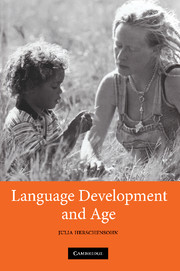Book contents
- Frontmatter
- Contents
- List of figures
- List of tables
- Preface
- Acknowledgments
- List of abbreviations
- 1 Just in time: is there a critical period for language acquisition?
- 2 Right on time: process and schedule of first language acquisition
- 3 All in good time: a window of opportunity for first language acquisition
- 4 Behind time: process and schedule of second language acquisition
- 5 Pressed for time: age constraints in second language acquisition
- 6 Biding time: further consideration of age and acquisition
- 7 It's about time: evaluation of age sensitivity in language acquisition
- Bibliography
- Index
3 - All in good time: a window of opportunity for first language acquisition
Published online by Cambridge University Press: 22 September 2009
- Frontmatter
- Contents
- List of figures
- List of tables
- Preface
- Acknowledgments
- List of abbreviations
- 1 Just in time: is there a critical period for language acquisition?
- 2 Right on time: process and schedule of first language acquisition
- 3 All in good time: a window of opportunity for first language acquisition
- 4 Behind time: process and schedule of second language acquisition
- 5 Pressed for time: age constraints in second language acquisition
- 6 Biding time: further consideration of age and acquisition
- 7 It's about time: evaluation of age sensitivity in language acquisition
- Bibliography
- Index
Summary
Introduction
A satirical piece in the New Yorker, “Talking chimp gives his first press conference,” parodies trained primates, the media, the scientific community and a number of other institutions. “Hello? Can everyone hear me? Anyone? Check, check. Check, one two. Is this thing on? Not the microphone – I mean my Electronic Larynx Implant device … The development of the ELI was a long and arduous process, and there were more than a few times – usually after being shot with a tranquillizer dart and then waking up hours later with excruciatingly painful bleeding stitch holes in my neck and chest regions – when I wasn't sure if it was worth it. But I guess it was, because here we are today, in this beautiful conference room at the Sheraton” (Simms 2005, 44). The humor of this monologue derives not so much from the reportorial scientific discourse or the monkey-business of the speaker (whose preoccupations are kibbles, orange wedges and bodily functions), but rather from the irony of our closest relative's inability to produce fluent language. Trained primates have learned vocabulary such as red toy or orange, and might be able to communicate (with signs) “hello” or “check, check,” but they could never articulate the complex syntax, temporal displacement and sophisticated vocabulary of the first full sentence.
- Type
- Chapter
- Information
- Language Development and Age , pp. 65 - 99Publisher: Cambridge University PressPrint publication year: 2007



